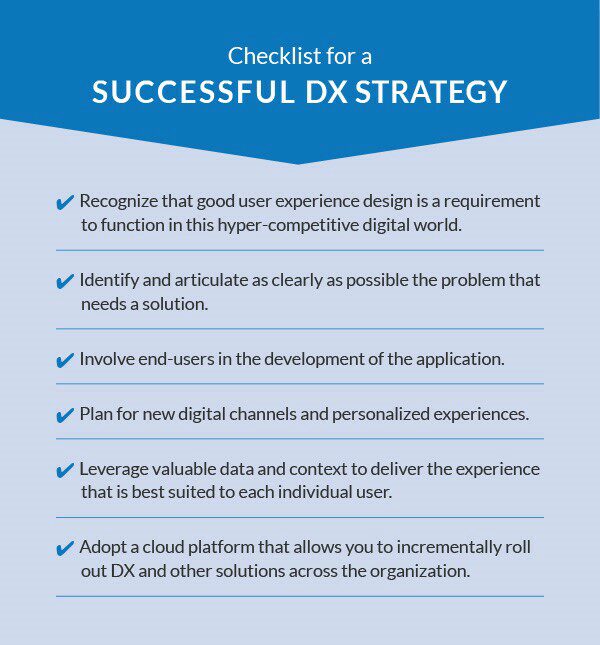The fast pace of technological change means that companies must move quickly or be left behind, ceding precious ground to competitors. But investing in on-premises technology is no longer a cost-effective and nimble way to quickly adapt to these changing needs. A better, more flexible and highly scalable strategy is to use a platform in the cloud to build applications that work across digital devices and can more ably address customer demands in real time.
A cloud approach impacts not just how data is stored but also how users could design and develop experiences. Today, with the explosion of digital technology tools, platform vendors are increasingly offering resources to enhance the digital experience (DX) for users, resulting in a greater ability of businesses and other organizations to enhance productivity and profitability, roll out new products and services faster — and across more markets — as well as develop longer-lasting relationships with employees, customers and other stakeholders.
But much work remains to be done. Despite efforts of many enterprises to delight consumers through digital channels, 84% of consumers surveyed across 11 industries said their experiences fall short of expectations, according to a September 2018 Gartner report.
In this white paper sponsored by SAP, Knowledge at Wharton explores the emerging trends in cloud platforms and how they make way for enhanced DX, which builds business value.
The Benefits of Using Cloud Platforms
Platform-as-a-service (PaaS) offerings such as Amazon Web Services, Microsoft Azure, SAP Cloud Platform and Google Cloud Platform offer organizations hosted hardware and software; applications and other tools. Levels of management across the stack vary from PaaS to software-as-a-service (SaaS) to infrastructure-as-a-service (IaaS). With SaaS, users leave management of the application (such as software updates) to tech providers like Dropbox or Concur. The level of third-party management drops with PaaS (Microsoft Azure) and further dips with IaaS (Rackspace).
According to Dan Lahl, vice president of product marketing at SAP, PaaS gives developers the platform to integrate existing applications and build custom ones. SAP Cloud Platform enables new applications to be built on any cloud infrastructure, be it Amazon, Microsoft or Google Cloud.
Today, platform providers are busy providing technology services for users through a set of integrated services that deliver delightful user experiences across various digital touchpoints. According to Jerry (Yoram) Wind, Wharton professor emeritus of marketing, experiences are “useful not only for communicating with or engaging consumers, but also with all the stakeholders, including internal business units of a company and employees.”
The cloud enables on-demand and quick access to products and services, which enhances the ability to develop digital experiences because IT teams don’t have to plan around long project cycles and commit significant budgets to experiment. The cloud lets a company respond promptly to new customer requests. The cloud also allows customers to access integrated services from one portal and receive customized experiences based on their online activity.
Advances in cloud platforms enable “more intelligent, personalized interactions across touchpoints beyond just smartphones and PCs,” said Scott Snyder, adjunct professor at the University of Pennsylvania’s School of Engineering and Applied Science, and senior fellow at Wharton’s Mack Institute for Innovation Management. “It also extends into things like sensors, wearables and robotics that enhance sense and enhance the environment around us.”
Snyder pointed to the emergence of advanced services such as digital assistants (Alexa, Cortana, and the like), real-time processing, and artificial intelligence (AI) resources like TensorFlow (an open source software library) and Azure Machine Learning, a cloud-based data science platform. Snyder is also a partner at the consulting firm Heidrick & Struggles, where he works with global companies in the areas of digital transformation and innovation.
The cloud enables on-demand and quick access to products and services, which enhances the ability to develop digital experiences because IT teams don’t have to plan around long project cycles and commit significant budgets to experiment.
Xuanming Su, Wharton professor of operations, information and decisions, said companies have long experimented with sourcing different business functions basically as a service-accounting as a service, logistics as a service, marketing as a service, and so forth. “This is fundamentally similar to decades-old outsourcing and contract manufacturing,” he said. “When activities are better done [externally], companies take them outside. Whether it is manufacturing or other business functions, it is always good to get things done cheaper and better and focus on core competencies.”
Su added that the benefits of using platforms are usually clustered around cost-effectiveness and access. They enable the spreading out or sharing of fixed costs, and allow smaller firms to access new technology without big investments. PaaS works for well-defined tasks like retail delivery and logistics or data analytics, but experimentation is underway on numerous other domains, he noted.
DX Gains from Platforms
Snyder listed the major areas where cloud platforms could bring benefits. One is in the customer experience, by creating a seamless physical and digital experience across touchpoints with personalization. Human resource management is another, where they could be used in various areas from “recruiting, to on-boarding, to on-going engagement/development — the ability to analyze and personalize the employee experience.” A third benefit is the ability to drive more efficient operations using IoT (internet of things), cloud and analytics.
Platforms help enhance the digital experience of consumers in two ways, Wind said. “One is when a company tries to personalize or customize the message as well as the offering to either an individual consumer or a segment of consumers,” he said. “The other approach is to have a platform that allows the consumers individually to customize their message and the offering to their specific needs — that is the ultimate in personalization.”
What People Want
There are different approaches to leverage a platform when building solutions for their customers, employees and partners, said Gunther Rothermel, senior vice president, SAP Cloud Platform Services at SAP, headquartered in Walldorf, Germany.
“When activities are better done [externally], companies take them outside. Whether it is manufacturing or other business functions, it is always good to get things done cheaper and better and focus on core competencies.”–Xuanming Su
One recurring pattern Rothermel sees is companies wanting to get directly in touch with their consumers, and be present in various channels such as on desktop and mobile, while having these interact with their business processes and backroom IT functions. “Omnichannel engagement is a big driver because it creates a sticky relationship with the customer and is even more important now with new channels such as conversation UIs (user interfaces),” he said.
The second type of approach is when an organization wants DX solutions to help explore the potential of previously untapped enterprise data. In such cases, typically they provide a set of APIs (application program interfaces) that developers or partners can build on to create innovative solutions. For example, a regional government body might make APIs available on traffic patterns that independent vendors could use to create mobile apps that help in decongesting traffic.
Rothermel cited the case of a coffee retailer with a “tree-to-cup” model where it wants to have direct relationships with coffee farmers and others all along the chain to bring a product to supermarket shelves. Cloud platforms offer the tools and scale to create a seamless experience across the ecosystem, from farmer to manufacturer to retailer, and allow them to collaborate with each other.
Companies that tap DX platforms typically need help in integrating their user-experience features with their backend systems. When businesses create omnichannel experiences, they spend only 30% of their time on developing the actual user interfaces and interactions, and 70% of the time on integration with underlying backend systems. Going back to the example of the coffee retailer, while it reaches out to consumers and farmers through new channels, it still has to generate invoices and ensure that the financial system is in place for loans to farmers, and others.
It helps if they have “reusable out-of-the-box content and templates,” Rothermel continued. “That translates into shorter implementation of projects, faster time-to-market, less effort and less cost. Customers could also collapse the time spent on delivering great experiences and backend integration.”
An Incremental Approach
Customers tend to test the waters by adopting DX strategies one bite at a time, instead of going in for, say, a million-dollar purchase of cloud-based services to cover all their needs, said Lahl. They use a “fast-fail” methodology, where they might take two to four weeks to build a prototype or proof-of-concept, and if that is successful, move on to develop the desired product or function.
A cloud approach impacts not just how data is stored but also how users could design and develop experiences.
If they are satisfied with the outcomes, they scale it to progressively cover all of their requirements. “That’s the beauty of the platform – it allows you to take a number of different services that all work together and then integrate back into the existing enterprise,” Lahl said. “You can run these projects in a fast-fail manner and then scale successes. So it’s a platform approach, but it’s applied project by project.”
For example, The Sika Group, a chemicals multinational based in Baar, Switzerland, used a cloud platform service in mid-2017 that transformed what was a problem in servicing its customers into sales opportunities. Construction projects regularly rely on Sika’s chemicals, and the containers holding those chemicals need to be refilled periodically. However, Sika’s sales teams often had a difficult time locating them among numerous other containers at construction sites.
Sika began installing sensors in the containers and connected them to geo-location services, which helped its sales representatives easily find them. Next, it installed another sensing device inside containers to measure quantities and alert sales personnel when they need to be refilled. An algorithm tracked the average consumption patterns for different chemicals, and Sika sales reps could predict consumption patterns and alert customers to replenishment needs.
The solution provided Sika’s top management granular and earlier visibility into the activities at the level of individual sales representatives. This brought further gains: improved sales forecasting, logistics, and inventory management and supply chain management. “This accelerated the sales cycle,” Lahl said. Sika used PaaS-based DX services to build these new functions. Its sales teams used a tablet to check on the chemical levels — with backend integration, a simpler experience and IoT service to create a powerful digital experience.
Experiences Centered on Valuable Data
Cloud platforms are also powering Waterwatch Cooperative, a four-year-old organization in the Netherlands that strives for water efficiency in irrigation. Building upon technology used in mapping and navigation services, it uses a platform approach to capture and integrate varied data feeds, in order to bring actionable insights and alerts to farmers around the globe.
“Omnichannel engagement is a big driver because it creates a sticky relationship with the customer and is even more important now with new channels such as conversation UIs (user interfaces).”–Gunther Rothermel
Waterwatch specializes in developing connected agricultural platforms, which brings efficiencies in data capture, analysis and dissemination of alerts through mobile apps. It captures data from satellites, weather tracking, monitoring of soil nutrients and other information sources in both conventional and innovative ways. “Without a platform strategy, it would have been impossible for us to integrate all the data from a variety of data sources, incorporate predictive analytics and develop applications,” said Harry Derksen, director and co-founder of Waterwatch, “to deliver field specific information to the farmer.”
For example, Waterwatch tracks soil nutrient levels by studying crop pictures that farmers capture on their smartphones and send. It also uses a variety of techniques to measure the “water footprint” and even “the sweating of plants” (moisture), enabling it to do crop classification, land classification and crop yield forecasting. It uses sophisticated algorithms to process all that data, and mobile apps to dispatch disease alerts and other guidance to farmers.
Waterwatch tracks those on a dynamic basis, and that is important because farm-level conditions are not static and historical data is not entirely reliable. For example, crop disease patterns are changing because of climate change. “Twenty years ago, a potato farmer could look at the sky and expect an attack of phytophthora (a common disease for that crop) and do some spraying,” Derksen said. “Now, he can be less certain about the weather and is often taken by surprise.”
Among the cooperative’s goals is to serve small farmers who cannot afford more expensive services – its crop disease alert costs $1 annually per field. The breakeven threshold is 100,000 farmers in a geographical area. Waterwatch’s current subscribers include 100,000 farmers in Vietnam, 170,000 small-holding farmers in Burundi, and 240,000 cocoa farmers in Ghana. “We want to reach not a thousand farmers or 5,000 farmers, but a million farmers and more,” Derksen said.
Cloud platforms offer the tools and scale to create a seamless experience.
Farmers that subscribe to Waterwatch’s services have seen improved yields, reduced losses due to diseases and better prices for their produce, according to Derksen. For example, thanks to its weather alerts, crop calendaring and crop monitoring, cocoa farmers in Ghana have been able to triple their average yields per hectare from 400 or 500 kg to up to 1,500 kg.
Simplifying the User Journey
Developing on a platform is unlike the traditional waterfall methodology where processes move in a linear fashion. Lahl said the platform approach moves project-by-project instead of a full lift-and-shift approach. Sika, for example, used a modular, “Lego-block” approach for the cloud platform. It began using it with an app that allowed sales reps to go to customer sites to place orders and put through discounts, then used IoT sensors to track the chemicals pipeline. All of those small pieces allowed them to transform the entire sales process over time.
A cultural shift also made it possible for The Mapal Group, a maker of precision tools in Aalen, Germany, to convert a problem into an opportunity. It hired a chief digital officer who created a digital community to share best practices on optimally using its drill bits. Mapal built an iOS application that allowed workers to report a broken or defective drill bit on an iPad, after scanning a QR code on it to pull up the relevant product information.
“Mapal received a defect report within roughly one or two minutes versus two weeks after the drill bit breaking,” Lahl said. The application also prompted the customer to immediately order a replacement drill bit, which he described as “a massive win for Mapal.” The order tied back into the company’s ERP system so that it could make good on a promise to deliver the drill bit on a specific date.
“That’s the beauty of the platform – it allows you to take a number of different services that all work together and then integrate back into the existing enterprise.”–Dan Lahl
Overall, the PaaS approach leaves people happier “because they’re part of the design and prototyping process,” said Lahl. It’s also proactive, since fixing the problems in an application would cost far more after delivery than doing so during the design or prototyping stages.
Overcoming Challenges
The ability to design effective experiences calls for certain prerequisites. One is identifying a need and articulating it well. “It’s a question of how you do best-in-class, sharp and precise definitions of what is needed,” said Rothermel. Another is empathy for the people using the app. Visual representations of the problem and suggested solutions also help, as well as “design thinking.” “Design thinking is a methodology where people come together in a structured way and follow the steps to uncover a problem description or problem solution,” he explained. The end-user must be involved in the design thinking process.
Some projects do fail. According to Rothermel, the biggest reason is that the application developed does not meet the needs of the business. To avert such an outcome, developers need to stay in touch with business users throughout the development process “in a very tangible, visible and graphical way if possible,” he said. “Sometimes, after initial conversations between the business users and the [development] team, a couple of months are spent in implementation, and when the business users come back, they say, ‘Well, this is not what I want.’”
Projects also run into problems when they are not well integrated with backend systems, Rothermel said. Platform vendors have to support the full “application lifecycle” to prevent disruptions as new software is introduced, he added.
Rothermel identified new imperatives for future generations of DX platforms: They have to incorporate new technology like machine learning, and they have to factor in shorter cycles. “The timelines in which companies consume digital experiences and innovation will shrink even more,” he said. CIOs will also want results faster because of increased pressure to reduce time to market for products and services. Cloud platforms have to also be “multi-cloud,” in that they need to accommodate a widening ecosystem of providers of cloud infrastructure.
Future Challenges
Future endeavors in perfecting cloud platforms will have to focus on achieving “a balance of edge versus cloud intelligence,” said Snyder. Edge computing refers to that which occurs at the level of devices such as smartphones or tablets. “As more use cases require real-time decisions, like self-driving cars or surveillance/security, AI and analytics will need be run closer to the user” or the device/equipment, he added. Cloud platforms could still host those processes if, say, 5G technologies could provide “a very low latency network for allowing this processing to happen in the cloud,” he added. “It is likely that the future will be a mix of cloud and edge for different use cases to optimize the DX.”




